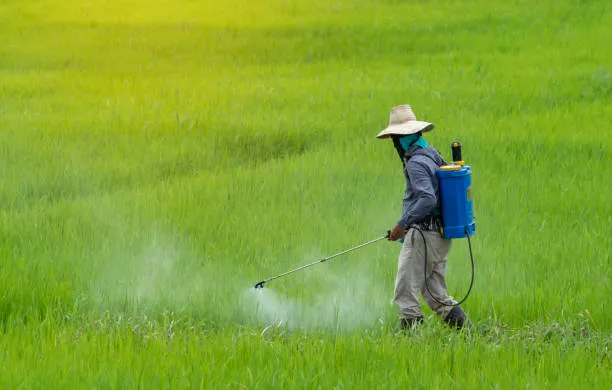Introduction to Tebuconazole 38.39% SC (Buonos)
Tebuconazole 38.39% SC, marketed as Buonos, is a systemic triazole fungicide widely used to control a broad spectrum of fungal diseases in crops. It belongs to the demethylation inhibitor (DMI) class and is effective against rusts, powdery mildews, leaf spots, and blights in cereals, pulses, vegetables, and horticultural crops.
Developed by Bayer CropScience, Buonos is known for its protective, curative, and eradicative action against fungal pathogens. Its long-lasting residual effect and plant health benefits make it a preferred choice among farmers.
Key Features of Tebuconazole 38.39% SC (Buonos)
| Property | Details |
|---|---|
| Chemical Class | Triazole Fungicide |
| Mode of Action | Demethylation Inhibitor (DMI) |
| Formulation | Suspension Concentrate (SC) |
| Target Diseases | Rusts, Powdery Mildew, Leaf Spots, Blights |
| Primary Crops | Wheat, Rice, Soybean, Grapes, Vegetables |
| Residual Effect | 14-21 days |
| Toxicity (WHO Class) | Moderately Hazardous (Class II) |
Mode of Action
Tebuconazole works by:
✔ Inhibiting ergosterol biosynthesis in fungal cell membranes.
✔ Disrupting membrane integrity, leading to fungal death.
✔ Providing systemic protection through xylem mobility.
It offers three-way action:
-
Protective – Prevents fungal infection.
-
Curative – Stops existing infections.
-
Eradicative – Eliminates dormant spores.
Target Diseases Controlled by Buonos
1. Cereal Crops (Wheat, Rice, Maize)
-
Leaf Rust (Puccinia triticina)
-
Powdery Mildew (Blumeria graminis)
-
Sheath Blight (Rhizoctonia solani)
2. Horticultural Crops (Grapes, Mango, Banana)
-
Anthracnose (Colletotrichum spp.)
-
Downy Mildew (Plasmopara viticola)
3. Vegetables (Tomato, Potato, Onion)
-
Early Blight (Alternaria solani)
-
Purple Blotch (Alternaria porri)
Application & Dosage Recommendations
1. Recommended Crops & Dosage
| Crop | Disease | Dosage (ml/acre) | Application Method |
|---|---|---|---|
| Wheat | Leaf Rust | 200-250 | Foliar Spray |
| Rice | Sheath Blight | 300-350 | Foliar Spray |
| Grapes | Powdery Mildew | 150-200 | Foliar Spray |
| Tomato | Early Blight | 200-250 | Foliar Spray |
| Soybean | Rust | 250-300 | Foliar Spray |
2. Best Practices for Application
✔ Apply at first disease symptoms for best results.
✔ Use high-volume sprayers for uniform coverage.
✔ Avoid spraying during high temperatures (>30°C).
✔ Maintain 7-10 day intervals between sprays.
Advantages of Using Buonos
1. Broad-Spectrum Disease Control
-
Effective against both foliar and soil-borne fungi.
2. Systemic Action
-
Moves upward in the plant (xylem-mobile).
3. Long Residual Effect
-
Provides 2-3 weeks of protection.
4. Plant Health Benefits
-
Enhances chlorophyll production (greener leaves).
5. Resistance Management
-
Can be rotated with strobilurins (e.g., Azoxystrobin).
Disadvantages & Limitations
1. Resistance Risk
⚠ Overuse can lead to fungal resistance (rotate with other fungicides).
2. Phytotoxicity Risk
⚠ High doses may cause leaf burn in sensitive crops.
3. Not for All Diseases
Ineffective against Oomycetes (e.g., late blight).
Safety & Environmental Impact
1. Toxicity Profile
-
Moderately toxic (WHO Class II).
-
Safe for bees when used as directed.
2. Pre-Harvest Interval (PHI)
-
14-30 days depending on crop.
3. Resistance Management
-
Rotate with fungicides of different MoA classes.
Comparison with Other Fungicides
| Fungicide | Mode of Action | Best For | Residual Effect |
|---|---|---|---|
| Tebuconazole | DMI Inhibitor | Rusts, Powdery Mildew | 14-21 days |
| Azoxystrobin | QoI Inhibitor | Early Blight, Downy Mildew | 7-10 days |
| Mancozeb | Multi-Site Inhibitor | Broad-Spectrum Protection | 5-7 days |
Farmer Feedback & Case Studies
-
Wheat Farmers (Punjab, India): Reported 25% higher yields with Buonos.
-
Grape Growers (Nashik, Maharashtra): Controlled powdery mildew effectively.
-
Tomato Cultivators (Andhra Pradesh): Reduced early blight damage by 80%.
Conclusion: Should You Use Buonos?
Yes, for rusts, mildews, and leaf spots.
No, for oomycete diseases (e.g., late blight).
Best Practices:
-
Follow recommended dosage.
-
Rotate with non-DMI fungicides.
FAQs
Q1. Can Tebuconazole be mixed with insecticides?
A: Yes, but check compatibility (avoid alkaline mixes).
Q2. How soon can I reapply Buonos?
A: After 14 days (if disease pressure persists).
Q3. Is Buonos safe for organic farming?
A: No, it’s a synthetic fungicide.
Q4. What’s the shelf life?
A: 2 years if stored properly.
For customized fungicide plans, consult an agronomist!
Sourashis Chanda brings readers their unique perspective on Business, Economy, Health and Fitness. With a background in Health and Physical Fitness of 2years, I am dedicated to exploring [what they aim to achieve with their writing, on the sustainable Economy of the country, various pro tips about business, latest goverment news, with some tips in health are and Fitness.







